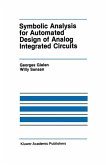The automation of layout synthesis design under stringent timing specifications is essential for state-of-the-art VLSI circuits and systems design. Especially, the timing-driven layout synthesis with optimal placement and routing of transistors with proper sizing is most critical in view of the chip area, interconnection parasitics, circuit delay and power dissipation.
This book presents a systematic and unified view of the layout synthesis problem with a strong focus on CMOS technology. The criticality of RC parasitics in the interconnects and the optimal sizing of both p-channel and n-channel translators are illustrated for motivation. Following the motivation, the problems of modeling circuit delays and translator sizing are formulated and solved with mathematical rigor. Various delay models for CMOS circuits are discussed to account for realistic interconnection parasitics, the effect of transistor sizes, and also the input slew rates. Also many of the efficient transistor sizing algorithms are critically reviewed and the most recent transistor sizing algorithm based on convex programming techniques is introduced.
For design automation of the rigorous CMOS layout synthesis, an integrated system that employs a suite of functional modules is introduced for step-by-step illustration of the design optimization process that produces highly compact CMOS layouts that meet user-specified timing and logical netlist requirements.
Through most rigorous discussion of the essential design automation process steps and important models and algorithms this book presents a unified systems approach that can be practiced for high-performance CMOS VLSI designs.
This book serves as an excellent reference, and can be used as text in advanced courses covering VLSI design, especially for design automation of physical design.
Moore's law [Noy77], which predicted that the number of devices in tegrated on a chip would be doubled every two years, was accurate for a number of years. Only recently has the level of integration be gun to slow down somewhat due to the physical limits of integration technology. Advances in silicon technology have allowed Ie design ers to integrate more than a few million transistors on a chip; even a whole system of moderate complexity can now be implemented on a single chip. To keep pace with the increasing complexity in very large scale integrated (VLSI) circuits, the productivity of chip designers would have to increase at the same rate as the level of integration. Without such an increase in productivity, the design of complex systems might not be achievable within a reasonable time-frame. The rapidly increasing complexity of VLSI circuits has made de- 1 2 INTRODUCTION sign automation an absolute necessity, since the required increase in productivity can only be accomplished with the use of sophisticated design tools. Such tools also enable designers to perform trade-off analyses of different logic implementations and to make well-informed design decisions.
This book presents a systematic and unified view of the layout synthesis problem with a strong focus on CMOS technology. The criticality of RC parasitics in the interconnects and the optimal sizing of both p-channel and n-channel translators are illustrated for motivation. Following the motivation, the problems of modeling circuit delays and translator sizing are formulated and solved with mathematical rigor. Various delay models for CMOS circuits are discussed to account for realistic interconnection parasitics, the effect of transistor sizes, and also the input slew rates. Also many of the efficient transistor sizing algorithms are critically reviewed and the most recent transistor sizing algorithm based on convex programming techniques is introduced.
For design automation of the rigorous CMOS layout synthesis, an integrated system that employs a suite of functional modules is introduced for step-by-step illustration of the design optimization process that produces highly compact CMOS layouts that meet user-specified timing and logical netlist requirements.
Through most rigorous discussion of the essential design automation process steps and important models and algorithms this book presents a unified systems approach that can be practiced for high-performance CMOS VLSI designs.
This book serves as an excellent reference, and can be used as text in advanced courses covering VLSI design, especially for design automation of physical design.
Moore's law [Noy77], which predicted that the number of devices in tegrated on a chip would be doubled every two years, was accurate for a number of years. Only recently has the level of integration be gun to slow down somewhat due to the physical limits of integration technology. Advances in silicon technology have allowed Ie design ers to integrate more than a few million transistors on a chip; even a whole system of moderate complexity can now be implemented on a single chip. To keep pace with the increasing complexity in very large scale integrated (VLSI) circuits, the productivity of chip designers would have to increase at the same rate as the level of integration. Without such an increase in productivity, the design of complex systems might not be achievable within a reasonable time-frame. The rapidly increasing complexity of VLSI circuits has made de- 1 2 INTRODUCTION sign automation an absolute necessity, since the required increase in productivity can only be accomplished with the use of sophisticated design tools. Such tools also enable designers to perform trade-off analyses of different logic implementations and to make well-informed design decisions.









